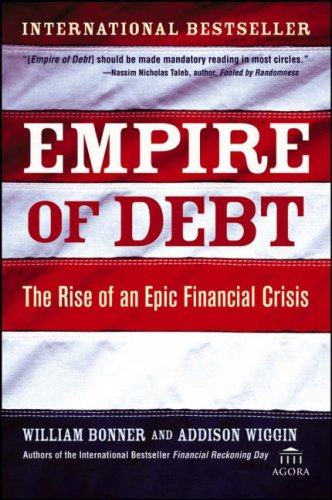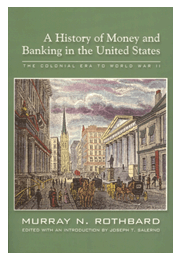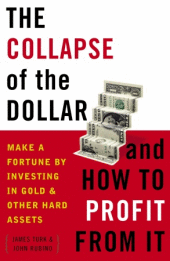
- Empire of Debt, a book that needed to be written
Empire of Debt: The Rise of an Epic Financial Disaster
Bill Bonner and Addison Wiggin
John Wiley & Sons 2006
384 pages. $27.95
“There are some people who still think Elvis is alive.” Such people are, of course, delusional.
According to Bill Bonner and Addison Wiggin – the authors of Empire of Debt – the general populace of America suffers from a grand delusion. Only America’s deluded condition has nothing to do with Elvis. America’s delusion is this: debt doesn’t matter, and “the rest of the world will take American IOUs forever.”
It’s a delusion that may well signal the end of the American financial system.
Bonner and Wiggen make their point in majestic style. Using the Roman Empire as their pattern, they demonstrate how empires should work. For one, a vast military machine is necessary. This machine not only keeps the peace, but it demands and collects tributary payments from its protectorates. For two, the empire has to keep the folks back home happy. It accomplishes this by providing freebies, which is nothing more than government welfare.
Essentially, then, running an empire is costly. The military machine is expensive to maintain. And the handouts to the common people eat up oodles of money. Which means a river of tributary money must flow into the empire’s coffers. Or the empire will go bust.The authors suggest the United States is an empire. It has an immense military, which demands prodigious infusions of money to keep it going. However, since the military does its job – keeps everyone safe – no one begrudges the cost too much. And America has a smorgasbord of welfare programs – there’s something for everyone – with which it tranquilizes the common people.
There’s only thing wrong with the American Empire. “Instead of getting paid for providing protection, the United States is on the receiving end of loans from its tributary states and trading partners.” In other words, instead of functioning as a proper empire, which means making a profit, America malfunctions as an Empire of Debt.
The reason for this malfunction is clear, say the authors. America wants to remake the world in its own image. Which means it eschews tribute. What America demands from its sidekicks is democratic capitalism. Bonner and Wiggin point out that – once upon a time – the Soviet Union did something similar. The Soviets tried “to remake its adversary into something more like itself.” The end result of these efforts drove the Soviet Union into bankruptcy and just like Humpty Dumpty the whole thing came crashing down.
The implication is that the same thing could be happening to the U.S.
Bonner and Wiggin also believe America’s increasing indebtedness to China is similar to the once mighty British Empire’s indebtedness to the U.S. in the mid-20th century. After World War II, the bottom dropped out and the British Empire faded. Great Britain is now a third-rate country. From riches to rags in just a few years.
The authors suggest that America has sold its birthright to China for a mess of pottage. They point out that “consumer spending is 71% of the U.S. economy. Current U.S. debt is about $37 trillion. The total value of all assets in America is only about $50 trillion.”
In short, America is broke.
Bonner and Wiggin go on to explain there are three ways for America to reduce its debt. The U.S. dollar can be devalued. The dollar can be made less valuable because of inflation. Or the debt may be forsaken. Needless to say, none of these options is very attractive.
Empire of Debt was published in 2006. It stated bluntly that the housing market occupied the center of an inflated bubble. The authors asserted the bubble would pop, leaving a sticky residue everywhere. They were right. The authors stated that Alan Greenspan’s policies were detrimental to the U.S. economy. They were right.
Empire of Debt not only identified the problems, but it provided a solution.
Invest in gold or the Japanese yen. It would appear that once again they were right. The yen is strong and gold has made a phenomenal run, selling for over $1000 per ounce.
Empire of Debt is written in an easy-to-read style. Which means it doesn’t read like a textbook on economics authored by eggheads for graduate students at Wharton. The reader doesn’t need a doctorate in economics to understand it. In fact, the opposite is true. If the reader wants to learn more about global economics and world financial history, this is the book to read. For the explanations are clear, the analogies are pertinent, and the conclusions are obvious.
Empire of Debt is written without a political agenda. It doesn’t present the conservative viewpoint as good, and the liberal viewpoint as bad. It doesn’t cheer for either Republicans or Democrats. In other words, the authors aren’t trying to sell you a party line. What the book does is present what some people would call a ‘contrarian’ view of global economics.
In reality, Empire of Debt bores a hole through all the misconceptions, delusions and unhealthy economic policies in existence at the present juncture of history. The light shines in, exposing all the traps and pitfalls of continuing in this direction. Because at the end of the passage, there’s an abyss called financial meltdown.
Empire of Debt is a book that needed to be written. And it needs to be read. For it will open your eyes to what’s really going on in the world. There really are economic monsters out there.
![]() On the Read-O-Meter, which ranges from 1 star (bankrupt) to 5 stars (opulent), Empire of Debt qualifies for 5 stars.
On the Read-O-Meter, which ranges from 1 star (bankrupt) to 5 stars (opulent), Empire of Debt qualifies for 5 stars.



